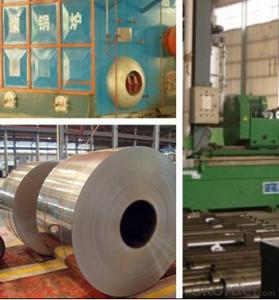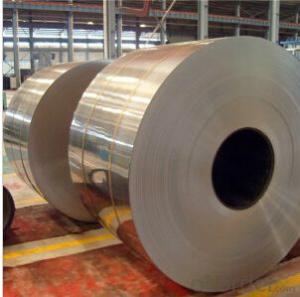High Quality Cold Rolled Steel for Building
- Loading Port:
- Tianjin
- Payment Terms:
- TT OR LC
- Min Order Qty:
- 25 m.t.
- Supply Capability:
- 10000 m.t./month
OKorder Service Pledge
OKorder Financial Service
You Might Also Like
Basic Info.
Certification:ISO
Technique:Cold Rolled
Standard:GB
Application:Container Plate
Edge:Slit edge
Stock:Stock
Steel Grade:SPCC DC05
Export Markets:Global
Additional Info.
Packing:According to The Customer Request
Standard:SGS. ISO
HS Code:72099000
Production Capacity:250000ton/Year
Product Details
Basic Info.
Technique:Cold Rolled annealing skim
Steel Grade:spcc dc05
Technique:Cold Rolled
Export Markets:Global
Approved Certificate:SGS & ISO
Surface Treatment:Oiled
Additional Info.
Trademark:xianghe
Packing:Standard Seaworthy Packing, Bundle or Pallet
Origin: Zibo,Shandong,China
HS Code:72099000
Product Description.
1.Thickness: 0.2mm-1.3mm
2. Width:660mm~1000mm
3. Inner Diameter: 508mm
4. Weight of Steel Coil: 3-15MT
5. Heat Treatment: Annealed
6. Surface Quality: FB&FC
7. Surface Status: SB & SD
| Skim the steel plate | Cold rolled steel sheet | ||
| width | Thickness(mm) | width | Thickness(mm) |
| 660mm~1000mm | 0.2mm-1.3mm | 660mm~1000mm | 0.2mm-1.3mm |
Cold Rolled Steel is steel that has been worked below its recrystallization temperature by passing it between a pair of rollers. Recrystallization temperature is the temperature at which grains in the lattice structure of the metal have been rearranged, leaving it free of strain and deformations. Cold Rolled Steel is pre-treated before being cold rolled with a process known as pickling, which uses strong acids to remove scale and other impurities. The Cold Rolled Steel is then passed through rollers to reduce its thickness.
- Q:What are the different methods of coil edge trimming?
- There are several methods of coil edge trimming that are commonly used in various industries. These methods include: 1. Shearing: This method involves using a shear blade to cut the edges of the coil. Shearing is a common method used for cutting thick coils and can be done manually or with the help of a machine. It provides a clean and straight cut but may not be suitable for thin or delicate materials. 2. Slitting: Slitting is a process in which the coil is passed through slitter knives that make multiple cuts along the edge to create narrower strips. This method is commonly used for producing narrow coils or strips of various widths. Slitting can be done in-line with a coil processing line or as a separate standalone process. 3. Laser cutting: Laser cutting is a precise method of coil edge trimming that uses a high-powered laser beam to cut through the material. It offers high accuracy and flexibility to cut complex shapes or patterns. Laser cutting is commonly used for thin or delicate materials, as it minimizes the risk of deformation or damage caused by other cutting methods. 4. Plasma cutting: Plasma cutting is a thermal cutting process that uses a plasma torch to cut through the coil. It is suitable for cutting a wide range of materials, including thick coils. Plasma cutting is known for its high cutting speed and ability to cut through materials with high melting points, such as stainless steel or aluminum. 5. Waterjet cutting: Waterjet cutting is a method that uses a high-pressure jet of water mixed with an abrasive material to cut through the coil. It is a versatile method that can cut a wide range of materials and thicknesses. Waterjet cutting provides a smooth and precise cut without heat-affected zones, making it suitable for sensitive materials. 6. Guillotine cutting: Guillotine cutting involves using a guillotine-style blade to cut through the coil. It is a quick and efficient method that provides a straight cut. Guillotine cutting is commonly used for cutting coils of various thicknesses and is often performed with the help of a machine for higher precision. Each method of coil edge trimming has its own advantages and considerations depending on the specific requirements of the application. The choice of method usually depends on factors such as material properties, thickness, desired cutting accuracy, production volume, and budget constraints.
- Q:What are the different types of steel surface treatments for coils?
- There are several types of steel surface treatments for coils, including pickling, oiling, galvanizing, and painting. Pickling involves removing surface impurities and scale through the use of acid solutions. Oiling is a process where a thin layer of oil is applied to the coil surface to prevent rust and improve handling. Galvanizing involves coating the steel with a layer of zinc to provide corrosion resistance. Painting is another surface treatment where a protective layer of paint is applied onto the coil surface to enhance durability and aesthetics.
- Q:What is the maximum load capacity for steel coil storage racks?
- The maximum load capacity for steel coil storage racks can vary depending on factors such as the design, dimensions, and construction materials of the rack. It is recommended to refer to the manufacturer's specifications or guidelines for accurate information on the maximum load capacity of a specific steel coil storage rack.
- Q:Help me compare the speed of sound in air, water, and steel please?Thanks.
- Sound travels fastest in steel and slowest in air. Water is in between. This is because the particles in solids are closer together than the particles in liquids or gases, and the particles in liquids are closer together than the particles in gases. The tighter particles are packed in a space, they collide more frequently. This allows sound, which is simply the combined collisions of particles, to travel fastest in solids. So, to reiterate, sound travels fastest in steel, then water, and slowest in air.
- Q:which metals have a higher density than steel? and how does the density compare to steel( example: tungsten carbide is 2x [i think] more dense than steel.)
- This Site Might Help You. RE: what metals are more dense than steel? which metals have a higher density than steel? and how does the density compare to steel( example: tungsten carbide is 2x [i think] more dense than steel.)
- Q:Can steel coils be coated with anti-tampering materials?
- Yes, steel coils can be coated with anti-tampering materials. These materials are commonly applied to steel coils to prevent unauthorized access or tampering, ensuring the integrity and security of the contents within the coils.
- Q:What is the role of steel coils in the oil and gas industry?
- Steel coils play a vital role in the oil and gas industry as they are used for various purposes such as storing, transporting, and processing oil and gas. These coils are designed to withstand high pressure and extreme temperatures, making them ideal for applications like oil storage tanks, pipelines, and refineries. Additionally, steel coils are used in the construction of drilling rigs, platforms, and other infrastructure required for oil and gas exploration and production. Overall, steel coils are essential components in the industry, ensuring the safe and efficient extraction, transportation, and processing of oil and gas resources.
- Q:What are the common methods of joining steel coils?
- The common methods of joining steel coils include welding, mechanical fastening (such as bolts or screws), and adhesive bonding.
- Q:How do steel coils compare to aluminum coils?
- Steel coils are generally stronger and more durable than aluminum coils. They have a higher tensile strength and better resistance to impact and abrasion. However, aluminum coils are lighter, more corrosion-resistant, and have better thermal conductivity. The choice between steel and aluminum coils depends on the specific application and the desired characteristics such as strength, weight, and corrosion resistance.
- Q:Why do we galvanise steel? Galvanised steel is steel coated with zinc.
- The coating of zinc inhibits rust. First of all the zinc does not oxidize a readily as iron (steel). If the zinc coating gets scratched it still protects the exposed iron. When the zinc and exposed iron get wet they behave like a battery. Electrons flow from the zinc layer to the iron layer. The extra electrons in the iron layer replace any that might be lost to oxidation and help keep the iron metallic. Of course now the zinc oxidizes faster so eventually all of the metallic zinc is removed and the iron is unprotected and will rust. The fact that the zinc doesn't have to cover the steel is shown in another process. To protect the steel hulls of ocean going ships a block of zinc is attached to the bottom. The electrical circuit behaves as described above. When the zinc block has dissolved they just attach another one. If they keep this up the hull of the ship remains corrosion free. A tin coating on steel (as in a tin can) works just the opposite. When the tin is scratched the electrons flow from iron to tin so the iron rusts faster than it would have with no tin.
1. Manufacturer Overview |
|
|---|---|
| Location | |
| Year Established | |
| Annual Output Value | |
| Main Markets | |
| Company Certifications | |
2. Manufacturer Certificates |
|
|---|---|
| a) Certification Name | |
| Range | |
| Reference | |
| Validity Period | |
3. Manufacturer Capability |
|
|---|---|
| a)Trade Capacity | |
| Nearest Port | |
| Export Percentage | |
| No.of Employees in Trade Department | |
| Language Spoken: | |
| b)Factory Information | |
| Factory Size: | |
| No. of Production Lines | |
| Contract Manufacturing | |
| Product Price Range | |
Send your message to us
High Quality Cold Rolled Steel for Building
- Loading Port:
- Tianjin
- Payment Terms:
- TT OR LC
- Min Order Qty:
- 25 m.t.
- Supply Capability:
- 10000 m.t./month
OKorder Service Pledge
OKorder Financial Service
Similar products
New products
Hot products
Related keywords




























